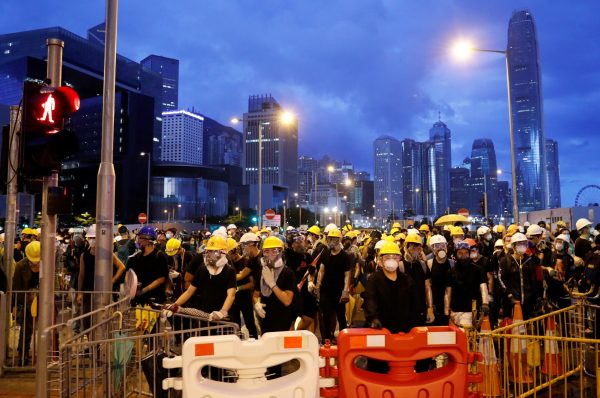Waves of wildcat strikes are disrupting the operation of public services. Mass petitions are being delivered to foreign consulates in Hong Kong. The publishing of protest statements in major international newspapers around the world during the G20 summit was a masterstroke in maintaining global attention on the fight.
While most of the protesters are highly disciplined and conscientious, some actions have been extremely dangerous. The standoff outside Police Headquarters on 21 June was one such precarious encounter. The city held its breath and prayed for restraint from both sides as thousands of police officers were barricaded in and abused by countless agitated youngsters until the early morning of the next day. The protesters are evidently in no mood to retreat unless there are further concessions from the government.
The government has turned itself into something resembling an absentee administration after announcing its decision to withhold the extradition bill indefinitely on 15 June. Hong Kong Chief Executive Carrie Lam has made few public appearances since then and events hosted by senior officials — including the meetings of the Executive Council, the key advisory body for the Chief Executive — were cancelled. Even the celebration of Reunification Day on 1 July was relocated to a more secure venue.
The government’s game plan is simple — make no further provocation and wait for the protesters to make a mistake.
The pro-Beijing establishment camp was probably excited to see protesters storming into the Legislative Council Building on 1 July. Protesters had been saddened by the news of a young woman who had decided to end her life, leaving a note supporting the protest a night before — the third such case in two weeks. A confrontation with police started in the early morning and eventually escalated into a forced intrusion into the building of the legislature. Conservative politicians lost no time in condemning the violence and felt empowered to call the intruders ‘rioters’.
Public responses have been mixed. While some segments of society feel angry about the naked challenge to law and order and there has been a general call for restraint from all corners, there remains solid support for the protesters’ cause. The Hong Kong people are fully aware of the root of the youngsters’ frustration and rage. For the majority of the local community, the fundamental question of why Carrie Lam cannot announce a formal retraction of the bill still needs to be answered.
The fate of Carrie Lam — who has claimed full responsibility for the mistake of historic proportions — is preordained. Her political career is effectively over. Not only did she trigger the most serious political crisis in Hong Kong since the 1997 handover, she also put the central government and Chinese President Xi Jinping in a hugely embarrassing situation at a time when China is already under severe pressure due to the trade war with the United States and the Huawei saga. Her lack of political judgement has been fully exposed and the damage to Beijing’s confidence in her ability to govern Hong Kong is irreversible.
Yet history says it may take some time before Beijing decides to wield the axe. In 2003, then chief executive Tung Chee-hwa suffered a similar defeat when he tried to push through legislation on sedition and treason against China. He only ‘resigned’ for ‘health reasons’ after almost 20 months. For Beijing, the succession issue is the first agenda of post-crisis management. It is likely to be followed by a major personnel reshuffle in departments and agencies involved in the administration of Hong Kong.
The results of the District Council election in Hong Kong in November 2019 will be crucial. Although District Councils are advisory bodies on community affairs with no executive power, they are important platforms for rewarding political loyalty. Most importantly, these elected local councillors are entitled to choose more than 100 members of the 1200-strong Election Committee that in turn elects the chief executive for Beijing’s appointment every five years. The result will be highly indicative of the actual damage caused by Carrie Lam’s mistake.
In the meantime, it would be a serious error for Carrie Lam to believe the storming of the Legislative Council has turned the political tide — public opinion has not been fully swayed by the violent scenes of 1 July. Unless further concessions from the government are unveiled soon, a new wave of protests is inevitable.
Dr Ray Yep is Professor of Politics and Associate Head of the Department of Public Policy at the City University of Hong Kong.

